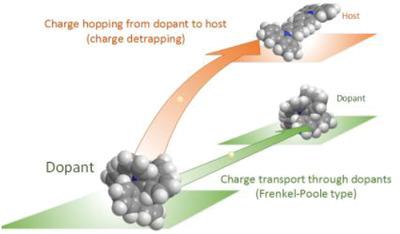当前位置:
X-MOL 学术
›
Adv. Electron. Mater.
›
论文详情
Our official English website, www.x-mol.net, welcomes your feedback! (Note: you will need to create a separate account there.)
Charge‐Transport Processes in Host–Dopant Organic Semiconductors
Advanced Electronic Materials ( IF 6.2 ) Pub Date : 2020-01-17 , DOI: 10.1002/aelm.201901147 Peicheng Li 1 , Zheng‐Hong Lu 1, 2
Advanced Electronic Materials ( IF 6.2 ) Pub Date : 2020-01-17 , DOI: 10.1002/aelm.201901147 Peicheng Li 1 , Zheng‐Hong Lu 1, 2
Affiliation

|
Host–dopant systems are the foundation for designing the light‐emission zones of organic light‐emitting diodes (OLEDs). An efficient OLED design has to consider the detailed charge transport processes in a host–dopant system in order to regulate charges for optimal distribution of excitons. It is reported that two charge transport pathways, Frenkel–Poole type transport via either host sites or dopant sites and charge hopping between host and dopant sites, are at play. The activation energy barrier in the hopping transport is identified as the energy level offset at the host–dopant interface, and is found consistent with the energy offset in the highest occupied molecular orbitals directly measured by ultraviolet photoemission spectroscopy. Dopant concentration and the host–dopant energy offset are identified as the key parameters dictating charge conduction path in the system. Practical equations are derived to calculate carrier mobility as a function of dopant concentration and dopant–host molecular energy offset.
中文翻译:

主体掺杂有机半导体中的电荷传输过程
主机掺杂剂系统是设计有机发光二极管(OLED)发光区的基础。有效的OLED设计必须考虑主机-掺杂剂系统中的详细电荷传输过程,以便调节电荷以优化激子的分布。据报道,有两种电荷传输途径,即通过宿主位点或掺杂剂位点的弗伦克尔-波尔型迁移以及在宿主和掺杂剂位点之间的电荷跳跃。跳跃传输中的活化能垒被识别为主体-掺杂物界面处的能级偏移,并且发现与通过紫外光发射光谱法直接测量的最高占据分子轨道中的能级偏移一致。掺杂物浓度和主体-掺杂物能量偏移被确定为决定系统中电荷传导路径的关键参数。推导了实用的方程式,以计算载流子迁移率随掺杂剂浓度和掺杂剂-主体分子能量偏移的变化。
更新日期:2020-03-09
中文翻译:

主体掺杂有机半导体中的电荷传输过程
主机掺杂剂系统是设计有机发光二极管(OLED)发光区的基础。有效的OLED设计必须考虑主机-掺杂剂系统中的详细电荷传输过程,以便调节电荷以优化激子的分布。据报道,有两种电荷传输途径,即通过宿主位点或掺杂剂位点的弗伦克尔-波尔型迁移以及在宿主和掺杂剂位点之间的电荷跳跃。跳跃传输中的活化能垒被识别为主体-掺杂物界面处的能级偏移,并且发现与通过紫外光发射光谱法直接测量的最高占据分子轨道中的能级偏移一致。掺杂物浓度和主体-掺杂物能量偏移被确定为决定系统中电荷传导路径的关键参数。推导了实用的方程式,以计算载流子迁移率随掺杂剂浓度和掺杂剂-主体分子能量偏移的变化。



























 京公网安备 11010802027423号
京公网安备 11010802027423号